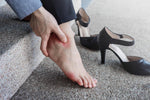
What Causes Heel Pain? A Comprehensive Guide to Understanding and Managing It
, by WALK HERO, 5 min reading time

, by WALK HERO, 5 min reading time
Heel pain is a common issue experienced by many, from athletes to those with more sedentary lifestyles. Ignoring it can lead to chronic discomfort or more serious foot conditions. By understanding what causes heel pain and how to address it, you can take the first steps toward recovery and improved foot health. In this guide, we’ll explore the most common causes of heel pain, risk factors, and how to prevent it.
One of the most common causes of heel pain is plantar fasciitis. This condition occurs when the thick band of tissue running across the bottom of your foot, the plantar fascia, becomes inflamed. The plantar fascia connects your heel bone to your toes and helps support the arch of your foot. Overuse, poor footwear, or standing for long periods can cause small tears in the fascia, leading to sharp, stabbing pain, particularly when you take your first steps in the morning.
Heel spurs are bony growths that develop on the underside of the heel bone. Often associated with plantar fasciitis, heel spurs can cause additional discomfort when the soft tissue in the heel becomes irritated. Although many people with heel spurs do not experience symptoms, those who do may feel pain similar to that of plantar fasciitis.
The Achilles tendon, which connects your calf muscles to your heel, can become inflamed due to overuse or repetitive strain, leading to Achilles tendinitis. This condition is common in athletes, particularly runners, and causes pain along the back of the heel. Symptoms include tenderness, swelling, and difficulty moving the foot. Stretching, resting, and physical therapy are often recommended for relief.
Bursitis occurs when the small, fluid-filled sacs (bursae) that cushion the bones, tendons, and muscles near your joints become inflamed. In the heel, this can be caused by overuse or wearing improper footwear. The pain from bursitis is typically felt at the back of the heel and worsens with activity.
Stress fractures are tiny cracks in the bone that often result from overuse or repetitive force, such as running long distances. These fractures can cause sharp, localized pain in the heel. Rest and a gradual return to activity are crucial for healing stress fractures.
Tarsal tunnel syndrome is a nerve condition that occurs when the posterior tibial nerve is compressed as it passes through the tarsal tunnel in the ankle. This compression can cause pain, tingling, or burning sensations in the heel and foot. Tarsal tunnel syndrome is often treated with rest, physical therapy, or, in severe cases, surgery.
Heel pain can be a symptom of rheumatoid arthritis, an autoimmune disease that causes the immune system to attack the joints. Inflammation from this condition can affect various parts of the body, including the heel. Managing rheumatoid arthritis with medication and lifestyle changes can help alleviate heel pain.
Gout is another less common cause of heel pain. It occurs when uric acid builds up in the blood, forming sharp crystals that can settle in joints, including the heel. A proper diet and medication can help manage gout symptoms and prevent flare-ups.
Sever’s disease is a common cause of heel pain in growing children and adolescents. It results from inflammation of the growth plate in the heel, usually triggered by repetitive stress from activities like running and jumping. Rest, ice, and supportive footwear are typically recommended to manage the pain.
As we age, the risk of developing conditions like plantar fasciitis and heel spurs increases. The natural wear and tear on the feet, combined with reduced flexibility in the tissues, makes older adults more susceptible to heel pain.
High-impact activities such as running, jumping, or dancing can increase your chances of experiencing heel pain. Overuse or improper training techniques often lead to conditions like Achilles tendinitis and plantar fasciitis.
Foot structure plays a significant role in heel pain. Flat feet, high arches, or abnormal walking patterns can cause excess stress on the heel and the surrounding structures. Custom orthotics can help correct these issues and alleviate discomfort.
Wearing shoes that lack adequate arch support or cushioning can contribute to heel pain. High heels, unsupportive flats, or worn-out athletic shoes can strain the heel over time. Choosing proper footwear is essential for both preventing and managing heel pain.
Heel pain can be a sign of various underlying conditions, and early intervention is crucial for effective treatment. By understanding the potential causes of your heel pain, you can take steps to prevent it from worsening and find relief through the appropriate treatments.
If you're experiencing heel pain, it's important to address it with the right footwear. Try the WALKHERO Arch Support Pain Relief Shoes, designed to provide enhanced arch support and cushioning to help relieve heel pain from conditions like plantar fasciitis and heel spurs. These shoes are perfect for everyday comfort and long-term foot health.